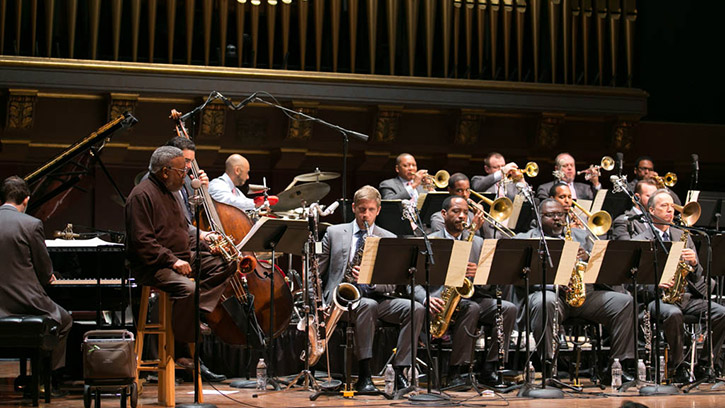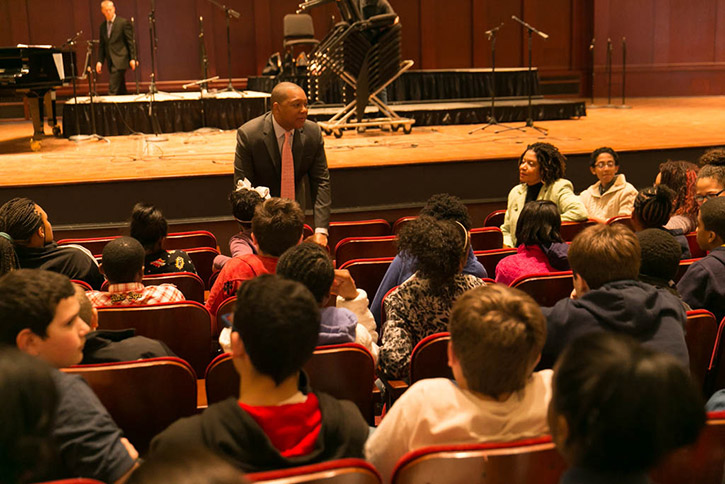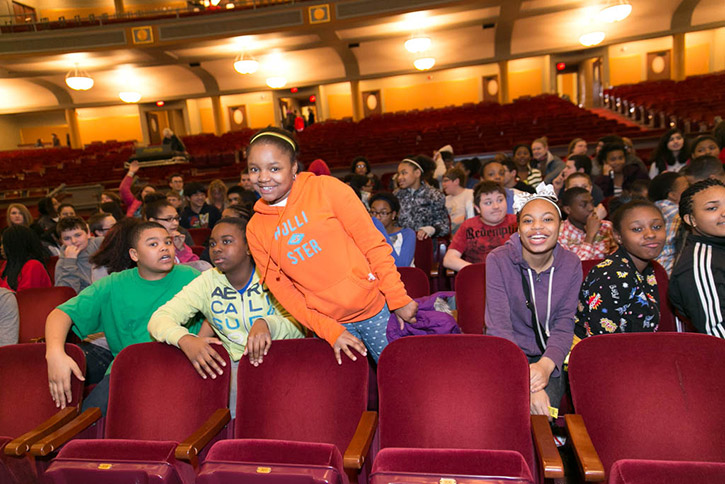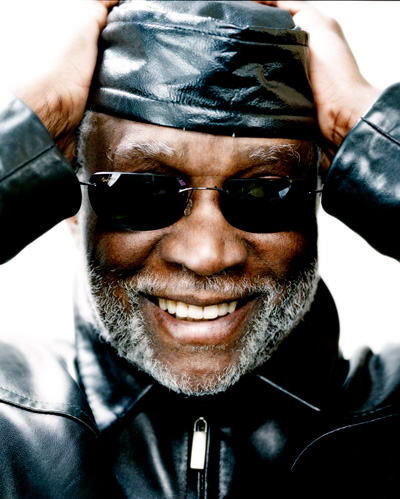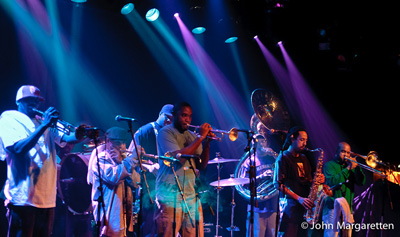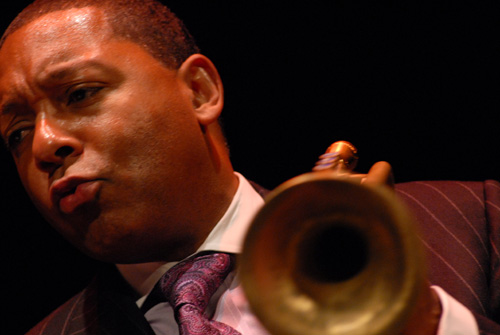Wynton Marsalis’s Musical Gifts
Wynton Marsalis and the Jazz at Lincoln Center Orchestra brought incredible musical gifts to Ann Arbor to kick off the Holiday season.
From an inspiring School Day Performance with 2,400 young people to a full house at Hill Auditorium, the legendary ensemble spread joy and good cheer with the debut of their “Big Band Holidays” national tour. Here are seven of our favorite moments:
1. Welcome Dinner
U-M Director of Athletics Warde Manuel and UMS President Matthew VanBesien welcomed Wynton Marsalis and the Jazz at Lincoln Center Orchestra members to a private dinner to kick off their week of rehearsals.

Warde Manuel, Wynton Marsalis, and Matthew VanBesien
Guests were treated to a performance with jazz students from Ann Arbor’s Community High School, who also spent time with Wynton and the band members throughout dinner.
2. A surprise guest!
U-M Jazz Studies student Ben Green got quite the surprise — a chance to play lead trumpet next to Wynton Marsalis in three rehearsals! On lightning fast notice, Ben graciously stepped in for a weather-stranded member of the Jazz at Lincoln Center Orchestra.
View this post on Instagram
3. School Day Performance
More than 2,400 K-12 students from 41 area schools, including 318 students from Detroit, brought anticipation and joy to the School Day Performance at Hill Auditorium.

4. Workshops in local schools
Many students participated in free pre-show workshops at their schools, where professional teaching artists introduced jazz and what the students could expect to experience at Hill.
5. Q & A with Students
Detroit High School students had the amazing opportunity to visit with JLCO’s bass player Carlos Henriquez, who shared his own experience of growing up in the South Bronx and how an afternoon school program and his commitment to music helped him become a professional musician.

6. Backstage with Wynton
Tappan Middle School students had a quick backstage “meet & greet” with the jazz great, who enthusiastically supports the ways UMS engages young people at a critical point in their lives.

7. Big Band Holidays!
Vocalists Vuyo Sotashe and Veronica Swift added to the holiday magic and big band sound of Wynton Marsalis and the JLCO.
View this post on Instagram
—
A huge thank you to Wynton and the Jazz at Lincoln Center Orchestra for a week of unforgettable experiences for audiences of all ages! Be sure to follow @WyntonMarsalis and @JazzDotOrg on Instagram as they tour into the new year.
Artist Interview: Jazz at Lincoln Center Orchestra, Kenny Rampton
University of Michigan student Teagan Faran spent Summer 2016 with the Jazz at Lincoln Center Orchestra as part of the UMS 21st Century Artist Internship program. The interview below is with Kenny Rampton, trumpet with the Jazz at Lincoln Center Orchestra. The group returns to Ann Arbor with pianist Chick Corea on March 31, 2018.

Photo: Left to right, Wynton Marsalis, Ryan Kisor, Kenny Rampton, and Marcus Printup. Photo by Frank Stewart.
Teagan Faran: How long have you been working with Jazz Lincoln Center?
Kenny Rampton: I joined full time in June 2010. I’ve been kind of in and out as a sub more or less since the 90s. I’ve known Wynton for a long time and had also been in and out of the band before it was an established, regular band. In the beginning, it was kind of a mix with players – maybe nine trumpet players – and Wynton would call upon us, and we’d play depending on who’s available. We were all freelancing with different bands and then eventually became a set band.
TF: What about the organization attracted you to join? What makes JLCO stand out?
KR: First and foremost is the educational aspect of it. I grew up in Las Vegas, and when I was a little kid, my parents were involved in music education. My mom actually fought the school district in Clark County, Nevada where I grew up because they were trying to fire all the music teachers in elementary schools. My mom was against that. She fought the school district to make sure that there was music education in the schools from elementary school on. My dad was a percussionist, and he played in all the schools for the kids. They were both about music education and from the time I was born, music education has been part of my life.
Coming here to New York, I was touring with Ray Charles and then with Mingus Band and Jimmy McGriff. They were all great gigs, but what makes JLCO and this organization stand out more than anything else is the education. We do a lot. I just finished a master class in Poland. I did one in Cuba and others all throughout South America. We do education all over the world. To me, that’s extremely important. For me, it’s full circle. It’s continuing my parents’ work.
The other thing is that it’s just a really good band. I like playing with people who are better than me. Playing in this trumpet session with Ryan Kisor, Marcus Printup and Wynton. It’s just inspiring.
TF: Do you feel like it’s more beneficial to be with the same people in a band and get to know them?
KR: With this band, yes. I’ve done other gigs, like Broadway shows where you’re playing the same music every night, the exact same way. That can be grueling. One thing about this band is that it’s the same people, but we’re always doing new music. Normally, most of the concerts we do are brand new arrangements for that specific concert.
We’re always challenging each other with the arrangements in the band, so that keeps it interesting and helps to maintain an environment where we’re all continuously growing. The better you get, the deeper you get into it, the more you realize there’s always room for improvement. No matter how good you get, there’s always another level to get to. It’s great.
TF: As a musician and arts educator, what do you think is different about what you’re trying to accomplish nowadays, as opposed to 10 or 15 years ago?
KR: For me personally, I’m more conscious of what it is I’m trying to do. I have more direction. Before, when I first got into playing music, it was something I was good at. I was drawn to music because of that, and it was about my ego. Then, I started to become aware that music is actually not about me. It’s actually my purpose. I consider music to be a spirit that touches people and can make a difference. I started to become more aware of that and realized that when we play music, it affects people’s mood. People can come out of a gig feeling good or feeling bad. We can consciously go into it, wanting to make a difference in somebody else and how they feel.
My purpose changed after realizing this. That’s the biggest difference for me in the last decade, as I started to see music as my way of making a positive difference on the planet and life. I started seeing music as something that can really change a life and make a real difference. You realize that music can touch the heart, the spirit, and raise their vibration. Because that’s what music is, it’s a vibration. It becomes more than about me and having somebody to tell me how good I sound. It becomes a spiritual quest or a calling.
There’re so many great humanistic qualities to learning to play jazz music that we can teach students. Whether they become professional musicians or not isn’t the point, but they will become better people. You can’t help but become a better person when you have empathy and when you know how to negotiate and work with other people.
You might be in disagreement about something, but you still work together and you find a common ground, that’s what music teaches us. When we teach students, I always stress that understanding. That’s really what it’s about.
TF: What would you say to a student who’s on the fence about attending the concert?
KR: Why would somebody be on the fence about attending a concert to hear good music? To any student, I say check out everyone and any concert you can that can possibly open up doors and inside yourself. It’s not even necessarily about doors to meet players and network, there’s that. You meet people so you network, and the more opportunities you can have to meet people who are doing what it is that you want to do, the better for networking purposes.
Beyond that, you never know when somebody on that stage is going to play something extraordinary. As a student, you sit there in the audience and think, “Wow, I didn’t know that can be done on the saxophone.” It’s going to open up something that makes you want to practice and to be inspired.
Jazz at Lincoln Center Orchestra returns to Ann Arbor with Chick Corea on March 31, 2018.
Updated 6/2/2017
Artist Interview: Jazz at Lincoln Center Orchestra, Vincent Gardner
Editor’s Note: University of Michigan student Teagan Faran spent several weeks with the Jazz at Lincoln Center Orchestra as part of the UMS 21st Century Artist Internship program. Jazz at Lincoln Center Orchestra is returning to Ann Arbor on March 4, 2017. The interview below is with Vincent Gardner, lead trombonist with the Jazz at Lincoln Center Orchestra.

Photo: Vincent Gardner with the Jazz at Lincoln Center Orchestra. Photo by Frank Stewart.
Teagan Faran: Could you tell us about your role at the JLCO?
Vincent Gardner: I’m the lead trombonist with the Jazz at Lincoln Center Orchestra. I’m also the director of the Jazz at Lincoln Center Orchestra Youth Orchestra, and I’m the Swing University professor. I teach classes here on jazz history and different aspects of jazz history. I’ve been here about 16 years.
TF: What about Jazz at Lincoln Center attracted to you initially?
VG: I guess when I first joined the band, I was what I’m still now, just a trombone player, who just had to play with the best musicians possible – well, musicians that I like and get along with and enjoy making music with. Those are also the ones who would inspire me to get better playing.
That was the biggest draw for Jazz at Lincoln Center. It’s a great organization. It inspires me and allows me to contribute to it. More so than just being a trombone player in a band, that is the difference. Here I have a chance to be a lot more invested in everything that goes on.
TF: Is there anything else that you would say makes Jazz at Lincoln Center stand out?
VG: I’m encouraged to connect to every part of the music. I think it’s essential in jazz music that you are always connected to every part of the music, not just what you play on your instrument. They’ve taken that philosophy here and put it into an institution, and that’s the greatest thing. You get to be involved. You’re encouraged to be involved as much as you want to be.
TF: What suggestions would you have for other ensembles that want to integrate music into their community in the same way that Jazz at Lincoln Center has?
VG: I would imagine that just about every community has great musicians or somebody doing great things in music or in the arts. You have to embrace those people and bring that community together under the guise of an institution that embraces all of the people who are doing great things for the arts.
We are a very big and prominent institution here in the city. In a smaller city, if you want to start an institution, you wouldn’t necessarily expect it to be as big, but it could still be very influential. You have to find out who the movers and shakers are in the arts. Who are the people that are genuinely trying to advance the arts and arts education in your city. Find out who the greatest teachers are, most genuine and greatest teachers are. Find the most talented kids, always get around the most talent.
It’s kind of the same thing playing in this group, being around the most talent and being around people who are most motivated. Once you find those people in any situation, you’ll find that you have similar goals.
TF: As a performing artist and arts educator, what are the biggest challenges you feel you’re facing today?
VG: Well, they are the same challenges. They’re not different. The biggest challenge is making sure that the same information is being communicated in the best way. For example, let’s talk about music instruction. The way they teach jazz music is not standardized. You have people who have the title of jazz educator or jazz band director, who are teaching complete misinformation to their students. Their bands don’t sound as good as a result, but because there is no other local standard or no standardized way of teaching it, they think it sounds fine. The community thinks it sounds fine because the community doesn’t really know the music anymore.
That’s one of the biggest things. You don’t find that in classical music, you don’t find that in other music. It’s only in jazz music, which is the music of this country, that you find such disparity in the level of teaching. That’s the thing I see the most in my teaching and in my traveling. It’s very hard at this point to standardize it and make sure it’s all on a high level.
TF: What would you say to a student who’s on the fence about attending a JLCO concert?
VG: I’d say, “It won’t hurt.” It definitely won’t hurt anything, and you’re going to hear a band full of great musicians, playing genuine music that has the ability to connect with people. It’s not something that’s marketed towards any one person or was ever meant to be reserved for any one group of people. That’s inherent in the sound of Swing. It can’t be played in a way that restricts it from anybody. It’s not possible to do that.
I would say that you will come, and you will find something in there that does connect with you. It could be different for every person, but it will be there because it’s inherent in music. It’s meant to connect with people. That’s the thing I would tell somebody: Take a chance. Everyone should give jazz a chance. Everyone should go to jazz concerts a few times a year.
Go to reconnect with that American ideal put into music – what’s great about society, about being American, and about people from anywhere.
Jazz at Lincoln Center Orchestra returns to Ann Arbor on March 4, 2017.
Artist Interview: Jazz at Lincoln Center Orchestra, Carlos Henriquez
Editor’s Note: University of Michigan student Teagan Faran spent several weeks with the Jazz at Lincoln Center Orchestra as part of the UMS 21st Century Artist Internship program. Jazz at Lincoln Center Orchestra is returning to Ann Arbor on March 4, 2017. The interview below is with Carlos Henriquez, bassist with Jazz at Lincoln Center Orchestra.

Photo: Jazz at Lincoln Center Orchestra with Carlos Henriquez on bass. Courtesy of the artist.
Teagan Faran: How long have you been with Jazz at Lincoln Center Orchestra?
Carlos Henriquez: About 15 years now.
TF: What about the organization attracted you to it?
CH: I was 13 when I met Wynton [Marsalis] through the Music Advancement Program at Juilliard. I just started hanging around him and going to some of the rehearsals. I started playing at the rehearsals, too, and then, just hanging. One thing led to another.
TF: What about Jazz Lincoln Center makes it stand out from other musical organizations to you?
CH: It’s the educational portion of it, the outreach program. JLCO is always looking for talent but also supporting other musical programs.
TF: What would you suggest to other ensembles that want to be a part of the community the way that Jazz Lincoln Center is in Manhattan?
CH: Well, I think they can look at the model for educational programming at JLCO. Many shows produced by JLCO start on a very small scale. It’s good to involve your community like we’ve done in New York and just find people who are really into the arts
TF: What are some of the challenges you think you face as a performer nowadays?
CH: The biggest challenge is the times. Times are changing, so what’s happening is that people are either not informed or their knowledge of music is very limited. People are more informed about pop culture than other culture. It’s complicated.
TF: What is the performance dynamic like in Ann Arbor?
CH: It’s always been an educational environment. Every time I’ve been there, it’s always working with students and the students seeing us play. That part is so great. Ann Arbor is also not far from Detroit, and there’re so many great Jazz musicians who come through that region. Every time we go, we usually meet great musicians and even play with them.
Jazz at Lincoln Center Orchestra returns to Ann Arbor on March 4, 2017.
Student Spotlight: Teagan Faran at Jazz at Lincoln Center Orchestra
This post is part of a series of posts by students who are part of our 21st Century Student Internship program. As part of the paid internship program, students spend several weeks with a company that’s on the UMS season.
U-M student Tegan Faran was paired with the Jazz at Lincoln Center Orchestra in Summer 2016. The group returns to Ann Arbor with pianist Chick Corea on March 31, 2018.


Left: A sunny day in NYC is well spent exploring Central Park. This was a favorite spot especially thanks to the nearby Dominican ice cream vendors. Right: Serenaded by 2 students of JALC’s WeBop Class learning about the instruments of a jazz band. All photos by Teagan Faran.
New York City is beyond famous. A museum on every corner, neighborhoods full of culture from every corner of the world, everywhere you look the Big Apple is the supreme destination for any tourist. Anyone staying in the city any longer may notice other (un)endearing traits: over-friendly rodents, the same faces camping out on the same subway stairs night after night, that very distinct aroma of over 8 million people sharing the same space. Amidst this wild jungle of life, though, an organization stands as the obvious crown jewel of NYC: Jazz at Lincoln Center. Overlooking the Central Park entrance at Columbus Circle, J@LC works to enliven an American art form, unite the people of NYC, and simply bring joy to as many as possible.


Left: fellow intern Kristina and I demonstrate the props for Essentially Ellington Festival’s social media booth. Right: Watching overhead as Wynton Marsalis directs a JLCO rehearsal.
Having only been in Manhattan for a single weekend before this summer, I had no clue what I was getting myself into when I stepped off the plane at LaGuardia. All I can say is that Manhattan truly lived up to its reputation of being a wild place to live!
I began my internship with the Education Department right as the fantastic whirlwind that is their Essentially Ellington Festival started up. The festival is the finale of the year-long program that Jazz at Lincoln Center has put together. Inspired by the idea that jazz should belong to everyone, J@LC has made numerous amateur-level jazz band scores available to schools all over the world. Schools that wish to compete in the Festival can send in a recording of their band playing some of these charts. From all these applicants, fifteen get to travel to New York to compete. The weekend is so much more than a competition, though; each day the students and teachers were immersed in the culture of jazz. Late night jam sessions, workshops with JLCO members, and a chance to perform in Frederick P. Rose Hall – these students truly got the treatment for this weekend!


Left: The majority of a successful show takes place backstage. Monitors in the back hallway track the artists on the Appel Room stage. Right: A performance in the Appel Room gives the audience two shows: musicians on stage and the city that never sleeps through the window.
It was my job to make sure that all of this happened smoothly. I was given a walkie-talkie and a brief tour of back stage before being set off into the crowd of excited students. I began by ushering a band from Utah over to their classroom for their first coaching with a JLCO member. I sat in the back of Dizzy’s watching the band rehearse and listening to Sherman Irby’s carefully thought-out critiques and encouragements. All the while, happy and nervous parents paced the back of the hall, telling me all about how hard the band had worked to prepare for the festival. The bands were also encouraged to get to know each other better throughout the weekend, and by the time the final ceremony ended, Rose Hall was filled with an obvious air of camaraderie and love.


Left: Speaking with the effervescently kind Cat Henry, VP of Concerts and Touring, about a career in arts administration. Right: I was lucky to meet Erika Floreska, former UMS employee, who now runs a community music school in Manhattan.
While all of this was happening, I was simultaneously discovering just what it took to live in Manhattan. Troubles with my housing situation led me to staying in about eight or nine different places in my seven and a half weeks in New York (forgive me, if I’ve lost track of the exact number!). I began to figure out which streets to avoid after sunset and learned how to avoid persistent cat-callers. Ever caring, however, my supervisors in the Education Department took me under their wing and helped to lessen the learning curve of Manhattan life. And this is what made my internship and this organization so incredibly noteworthy: the people behind the idea.


Left: Wherever you turn in NYC, there is ample opportunity to be a tourist. Looking back on Manhattan, the sun breaks past the World One Observatory. Right: My home for two months at Columbus Circle.
Rewind for a second, back to my very first day with J@LC. I was sat down in a conference room and given a large stack of papers – some to sign, but mostly to read. In these packets were the words written by Wynton Marsalis about this very organization. “The mission of Jazz at Lincoln Center is to entertain, enrich, and expand a global community for Jazz…we believe Jazz is a metaphor for Democracy…it inspires us to face adversity with persistent optimism,” reads the organization’s mission statement online. The packet I was given included Mr. Marsalis’s expanded ideas on this topic and his guidelines for how J@LC is to be run. I heard it said at some point that he runs the office in the same way he runs a rehearsal: everyone is responsible for their own ideas and strategies, but all are working towards the common goal.


Left: Band members and parents file past for the 2016 Essentially Ellington Competition. Right: A city saturated in culture! I enjoyed walking from Columbus Circle to see shows by the American Ballet Theatre and the New York Philharmonic at Lincoln Center.
Manhattan is loud in a busy, noisy, smelly way, and a person begins to look for quiet wherever she can find it. Identifying your favorite patch of grass in Central Park, ducking into that French bookstore to admire the constellations on the ceiling, or grabbing a dollar ice cream scoop from the Dominican shop on the corner, these all make for great meditation. My absolute favorite place in Manhattan, however, has to be the backstage hallway leading to the Appel Room. One of J@LC’s main stages, the Appel Room sets the band up with a glass backdrop that opens to a view to Columbus Circle in all its mayhem. As the band swings, taxis stream by and tiny people scurry across the crosswalk beneath. It was here that I spent my first weekend in the Concerts and Touring department.
Acting as a musician’s assistant, I got exposed to the behind-the-scenes world of making sure all the artists had water and towels and any other necessary commodity in order to ensure their best performance. The most important part of my time with Concerts and Touring was not the quick trips to Whole Foods to buy backstage snacks or the in-office historical work, but rather the opportunity to join in this “jazz family.” Every single person I met was so immediately ready to be a close friend and an ally. Even after the show ended, I would run into musicians on the subway and be greeted by a warm hug and a smile. A few of us even ended up at one of the free Concerts in the Parks programs, determined to hear greats such as McCoy Tyner in person. As we walked to the park, we saw the clouds getting darker but pushed onward anyhow. Even as the rain began to pour down, we laughed and grooved along to the musicians on stage. Afterwards, we wrung out our jackets on the subway and laughed together about the concert.

Photo: A life changing show by Christian McBride at the famous Blue Note jazz club.
The idea of the Jazz Family came out in full form one bright, Sunday afternoon as the JLCO gathered a crowd to remember the Great Joe Temperly. A stoically happy occasion, the JLCO and students of Mr. Temperly came together to share stories and treat everyone to a New Orleans-esque jam in honor of the late tenor saxophonist. Though the room was full of strangers, this music truly united everyone present. This is what J@LC exemplifies in their work every single day.
I am beyond grateful to the UMS and to Jazz at Lincoln Center for this internship opportunity. There are so many more stories that I would love to share about my time in New York City, but I can say one thing for sure: the level of inspiration and brotherhood that I experienced this summer can be experienced every time the JLCO hits the stage. They are a truly magical ensemble and organization.
This Spring, welcome back to Ann Arbor, JLCO, we are so excited to have you here.
See the Jazz at Lincoln Center Orchestra with Chick Corea on March 31, 2018.
Updated 6/2/2017
School Day Performance with JLCO
The Jazz at Lincoln Center Orchestra and Wynton Marsalis return to Hill Auditorium on March 4, 2016.
The orchestra and Wynton Marsalis have visited Ann Arbor many times since their debut in 1994, and during our 2013-2014 season, the musicians received the UMS Distinguished Artist award. This group is special not only because of their superb music making; the orchestra’s dedication to education programs is also remarkable.
Check out these photos from a School Day performance during our 2013-2014 season. The orchestra on stage:
Wynton Marsalis chats with students after the performance:
Happy students in the auditorium:
Photos by Mark Gjukich Photography.
Last updated 4/29/2016.
Interview: Ford Honors Program featuring JLCO and Wynton Marsalis
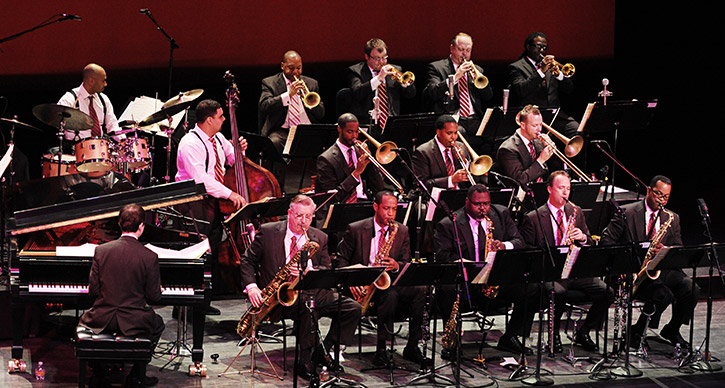
Photo: Jazz at Lincoln Center Orchestra and Wynton Marsalis in concert. They’ll perform in Ann Arbor on March 30, 2014. Photo by Frank Stewart.
Each year, the UMS Advisory Committee (an organization of over 60 volunteers who contribute over 7,500 hours of service to UMS each year) works together with UMS staff on the UMS Ford Honors Program Gala. FHP is our annual benefit that supports UMS’s Education & Community Engagement Program, which provides free or low-cost education and community engagement activities focusing on K-12 students, teachers, teens, university students, families, adults, and cultural communities. Funds raised from the Gala make it possible for UMS to impact nearly 20,000 youth, educators, and community members each season.
This year, we’re excited to honor Wynton Marsalis and the Jazz at Lincoln Center Orchestra, artists who have a long history with UMS, and also a deep commitment to education.
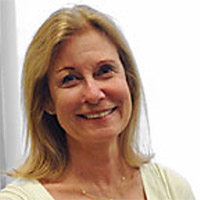 We sat down with Cheryl Cassidy, who’s leading the FHP efforts this season. Cheryl is a resident of Ann Arbor and a professor in the English department at Eastern Michigan University.
We sat down with Cheryl Cassidy, who’s leading the FHP efforts this season. Cheryl is a resident of Ann Arbor and a professor in the English department at Eastern Michigan University.
Caroline Kagan: What are you most excited about in this year’s program?
Cheryl Cassidy: I’m always excited about Ford Honors. We have been going, my late husband and I, and my daughter also, for the past thirteen, fourteen years. For me and for my family it’s always been a really exciting thing to be with people who are interested in the arts and to be a part of that community.
Of course I’m excited this year because Wynton Marsalis is just such a stellar performer. To be part of planning the whole thing is exciting, too. It’s fun, and it’s nice to be a contributor in a way that is very meaningful.
CK: Have you attended Jazz at Lincoln Center Orchestra and Wynton Marsalis performances in the past? If so, what do you like about them?
CC: You know, I thought about this question, and I was trying to think, what is it? I think a part of it is that not only does Wynton Marsalis excel at what he’s doing in his art, but he also has this very uncommon ability to transcend his medium. He goes beyond what’s predictable, in terms of musical boundaries, as does the Jazz at Lincoln Center Orchestra. Along with that there’s this inclusivity that happens, so that the audience and the performers feel a part of the whole experience. That’s both a very fragile and a very unusual thing.
Secondarily, I’m excited because Wynton Marsalis and the Jazz at Lincoln Center Orchestra have such an impact on our community. They’ve created possibilities for educational experiences for students, particularly those students who, under normal circumstances, would not be able to attend a concert like this. Of course the donors for this performance and gala are then supporting the continuation of those educational programs.
CK: Related to that thought, what do you think the Ford Honors Program brings to the community at large?
CC: I think the Ford Honors Gala in general and this particular performance and honoree in particular really reflect our community’s devotion to the arts. It’s not just a singular devotion. I think it’s very multifarious. In other words, it includes universities like the University of Michigan and Eastern Michigan University, the community in Ann Arbor, Ypsilanti, and beyond in the region. Wynton Marsalis and the JLCO really appeal to a great number of people. The gala reflects our commitment and our devotion to these stellar performers and indicates how much we value their creativity and how it enriches our lives.
CK: You also chaired the committee that planned the 2006 Ford Honors Program, which honored jazz pianist and composer Dave Brubeck. What did you learn from that experience, and how have you incorporated those insights as you plan for this Ford Honors Program?
CC: I think the most important thing that I learned and that I experienced was the importance of having a really good team, a team of people who are dedicated and who are highly invested in the event, and we’re very lucky to have a great team working on this year’s FHP.
CK: Now I’m going to ask you a very hard question. Why do you support the arts?
CC: That is a hard question and that involves so much emotion. I think that for me, personally, the arts really enrich my life. And I think that the arts are part of how we are human. We have to incorporate the arts into our lives, because that makes us better people, better community members, better people in the world, because the arts transcend cultures. They are for the world and for everyone.
I buy into all that, but I think also my late husband was just fiercely devoted to UMS. He wanted to go to every concert and I sort of had to say, “We can’t do it all!” He was really a person who treasured the idea that UMS was here in Ann Arbor, as do I. So I’ve been very conscious of that legacy, as has my daughter, and I think that’s part of it as well.
Interested in learning more about this year’s Ford Honors Program? Visit our FHP event page where we’ll keep the most up-to-date information about the gala.
Educator Conversations: Jazz at Lincoln Center Orchestra with Wynton Marsalis
Editor’s note: This post is a part of a series of conversations between educators in the K-12 community. Educators will offer suggestions and answer questions about integrating UMS School Day Performances or the arts into classroom curriculum, as well as share advice on organizing a field trip to UMS. To volunteer to be a Teacher Lobby Moderator e-mail umsyouth@umich.edu. Or, check out other Educator Conversations.
This week’s questions:
- What does Jazz music have in common with the music of Mozart and Haydn?
- How does Jazz music reflect the values of African-American culture from which it came?
- How do you find yourself improvising in your life?
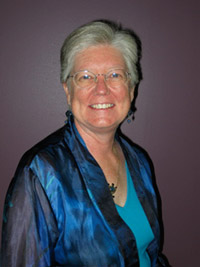 This week’s moderator: Linda Jones. Linda has taught music, math and media in the Ypsilanti Schools from 1999 to 2012. She is currently director of the Ann Arbor Civic Chorus. She has taught jazz history, composition, improvisation and performance as well as acting and creative movement at the elementary level and collaborated with bassist Paul Keller, drummer Sean Dobbins, and pianist Ellen Rowe. She has training as an Orff Music Educator and currently serves as Treasurer to the Greater Detroit Orff Schulwerk Association. She has presented workshops on Jazz improvisation and Composition through Garage Band.
This week’s moderator: Linda Jones. Linda has taught music, math and media in the Ypsilanti Schools from 1999 to 2012. She is currently director of the Ann Arbor Civic Chorus. She has taught jazz history, composition, improvisation and performance as well as acting and creative movement at the elementary level and collaborated with bassist Paul Keller, drummer Sean Dobbins, and pianist Ellen Rowe. She has training as an Orff Music Educator and currently serves as Treasurer to the Greater Detroit Orff Schulwerk Association. She has presented workshops on Jazz improvisation and Composition through Garage Band.
Q: What does Jazz music have in common with the music of Mozart and Haydn?
They both use western harmonic progressions, they both use the same instruments, especially percussion, winds and brass and bass violins. They both have soloists and ensembles. Improvisation is at the heart of Jazz and traditionally there was also improvisation in Baroque performances.
What else can you add to this list?
Q: How does Jazz music reflect the values of African-American culture from which it came?
Everyone has a voice and contributes equally to the ensemble.
Everyone has a chance to shine and show their individual talent.
Collaboration is very important.
Lyrics reflect the reality of life, the loves and struggles, the hope and the suffering.
Talent is mentored and held to a high standard.
Rhythm is the basis of music that cooks, this rhythm flows through all of African-American life.
What else would you include in this list?
Q: How do you find yourself improvising in your life?
I find that teaching is filled with chances to improvise. Lesson plans are only an outline, the craft is in fitting those plans with the needs of the learners present on that day. Any time I am leading a choral rehearsal, I am improvising wildly as I find ways to help the choir improve. Driving also presents plenty of chances to improvise, especially if different routes are possible to get to the destination.
How do you improvise?
Do you have questions or comments for Linda about his approach to this performance or about teaching through performance more broadly? Share your responses or questions in the comments section below.
11/12 Jazz Series
With four different events, the UMS Jazz Series celebrates jazz’s diversity, highlighting the best in contemporary jazz while honoring jazz’s legacy. Concerts include NEA Jazz Master and pianist Ahmad Jamal with James Cammack, Herlin Riley, and Manolo Badrena; A Night in Treme: The Musical Majesty of New Orleans featuring the Rebirth Brass Band; the Jazz at Lincoln Center Orchestra with Wynton Marsalis; and the Charles Lloyd Quartet, with 2010 MacArthur Fellow Jason Moran, Reuben Rogers, and Eric Harland.
Subscription packages go on sale to the general public on Monday, May 9, and will be available through Friday, September 17. Current subscribers will receive renewal packets in early May and may renew their series upon receipt of the packet. Tickets to individual events will go on sale to the general public on Monday, August 22 (via www.ums.org) and Wednesday, August 24 (in person and by phone). Not sure if you’re on our mailing list? Click here to update your mailing address to be sure you’ll receive a brochure.
An Evening with Ahmad Jamal
Ahmad Jamal, piano
James Cammack, bass
Herlin Riley, drums
Manolo Badrena, percussion
Saturday, September 17, 8 pm
Hill Auditorium
“Ahmad Jamal is not just a living legend of jazz; he is one of the most inspired and inspiring artists in music today.” (AllAboutJazz.com) A key influence on Miles Davis and countless others, NEA Jazz Master Ahmad Jamal incorporates a unique sense of space in his music, and his musical concepts are exciting without being loud in volume. Born in Pittsburgh 80 years ago, Jamal is playing better than ever, with lifetime achievement awards feeling premature given his ongoing desire to push the genre forward.
A Night in Treme: The Musical Majesty of New Orleans
Rebirth Brass Band with special guests from New Orleans
Friday, November 11, 8 pm
Hill Auditorium
The Treme (pronounced truh-MAY) neighborhood of New Orleans has been a source of African-American music and culture for as long as cooks in the Crescent City have been serving red beans and rice on Monday nights. Birthplace of the great New Orleans brass band tradition and one of the first black neighborhoods in America, Treme is the heartbeat of New Orleans and the home to Congo Square. In conjunction with the airing of the second season of the HBO series, which follows a variety of New Orleanians as they try to rebuild their lives in the aftermath of 2005’s Hurricane Katrina, this concert features the legendary Rebirth Brass Band, known for combining traditional New Orleans brass band music, including the New Orleans tradition of second line with funk, jazz, soul, and hip-hop influences.
Jazz at Lincoln Center Orchestra with Wynton Marsalis
Wynton Marsalis, artistic director and trumpet
Wednesday, February 22, 7:30 pm
Hill Auditorium
The February 2010 snowstorm was about the only thing that could keep Wynton Marsalis and the Jazz at Lincoln Center Orchestra away from Ann Arbor! Despite one of the most aggressive touring schedules in the business, JLCO makes each concert fresh, drawing in audiences who are continually energized and amazed by the group’s depth of outrageous talent.
Charles Lloyd Quartet
Charles Lloyd, tenor saxophone and flute
Jason Moran, piano
Reuben Rogers, bass
Eric Harland, drums
Saturday, April 14, 8 pm
Michigan Theater
Forty years ago, saxophonist Charles Lloyd was a pop star; his 1966 album, Forest Flower, sold a million copies. Four years ago, at 69, when most individuals are thinking of ways to slow down and kick back, Charles Lloyd shifted to a higher gear and formed a new quartet. Lloyd has always led exceptional bands, and this is perhaps the best. With 2010 MacArthur Fellow Jason Moran on piano, Reuben Rogers on bass, and Eric Harland on drums, the Quartet’s concerts are events of pristine beauty and elegance, full of intensely felt emotion and passion that touches deep inside the heart.
Return to the complete chronological list.
17th Annual Jazz Series Announced
With four different events, the UMS Jazz Series celebrates jazz’s diversity, highlighting the best in modern jazz while honoring jazz’s legacy:
Silent Surrealism
Celebrating Django Reinhardt’s 100th Birthday
The Hot Club of San Francisco
The Hot Club of Detroit
Friday, October 29 | 8 pm
Michigan Theater
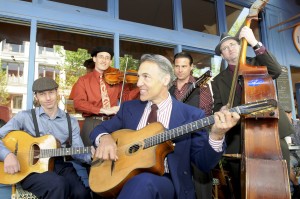 The Hot Club of San Francisco is an ensemble of accomplished and versatile musicians celebrating the music of Django Reinhardt and Stéphane Grappelli’s pioneering Hot Club de France. Fast forward 80 years. Continuing this early French tradition, a similar scene plays out as the Hot Club of San Francisco presents Silent Surrealism, an evening of live Gypsy jazz with short silent films from the 1930s by Charlie Bowers, James Sibley Watson, and Harold Shaw, courtesy of the San Francisco Silent Film Festival. Django Reinhardt is rightly hailed as one of the greatest guitarists who ever lived, but many people praising his accomplishments as a guitarist tend to overlook his roots in Gypsy culture and the fertile, polyglot Paris of the 1920s. Reinhardt and his companions used all these elements, along with American jazz, to create this new music, but the Gypsy heritage seems to be the most important ingredient. The Hot Club of San Francisco and the Hot Club of Detroit join together for this celebration of Django Reinhardt’s 100th birthday.
The Hot Club of San Francisco is an ensemble of accomplished and versatile musicians celebrating the music of Django Reinhardt and Stéphane Grappelli’s pioneering Hot Club de France. Fast forward 80 years. Continuing this early French tradition, a similar scene plays out as the Hot Club of San Francisco presents Silent Surrealism, an evening of live Gypsy jazz with short silent films from the 1930s by Charlie Bowers, James Sibley Watson, and Harold Shaw, courtesy of the San Francisco Silent Film Festival. Django Reinhardt is rightly hailed as one of the greatest guitarists who ever lived, but many people praising his accomplishments as a guitarist tend to overlook his roots in Gypsy culture and the fertile, polyglot Paris of the 1920s. Reinhardt and his companions used all these elements, along with American jazz, to create this new music, but the Gypsy heritage seems to be the most important ingredient. The Hot Club of San Francisco and the Hot Club of Detroit join together for this celebration of Django Reinhardt’s 100th birthday.
Jazz at Lincoln Center Orchestra with
Wynton Marsalis
Wednesday, February 2 | 8 pm
Hill Auditorium
Led by the incomparable Wynton Marsalis, who conceived and built this ensemble into the irresistible force it is today, the 15-member Jazz at Lincoln Center Orchestra returns for its near-annual Hill Auditorium appearnace. Despite one of the most aggressive touring schedules in the business, they make each concert seem fresh, drawing in audiences who are continually energized and amazed by the group’s depth of outrageous talent. “[The Jazz at Lincoln Center Orchestra] is not just a band on tour, but a religious congregation, spreading the word of jazz.” (Downbeat)
Vijay Iyer Trio and Rudresh Mahanthappa’s Apex
Saturday, February 12 | 8 pm
Power Center
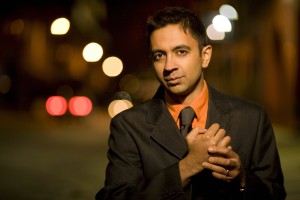 This double bill brings together two of today’s most interesting jazz combos. Dubbed one of “today’s most important pianists” by The New Yorker, Vijay Iyer is a singular talent: a forceful, rhythmically invigorating performer who weds a cutting-edge sensibility to a unique sense for compositional balance. An exceptional, forward-thinking composer, Iyer draws from African, Asian, and European musical lineages to create fresh, original music in the American creative tradition. His latest album, Historicity, received year-end acclaim for #1 Jazz/Pop Album of the Year (The New York Times) and #1 Jazz Album of the Year (National Public Radio and The Los Angeles Times). The second half of the program features alto saxophonist Rudresh Mahanthappa’s quintet Apex, which will be co-led by Mahanthappa and trendsetting septuagenarian hard-bop saxophonist Bunky Green. Mahanthappa, (who appears with Danilo Perez on April 8 at the Michigan Theater) is one of the most innovative young musicians and composers in jazz today. The two ensembles perform separate sets, then come together for a searing finale.
This double bill brings together two of today’s most interesting jazz combos. Dubbed one of “today’s most important pianists” by The New Yorker, Vijay Iyer is a singular talent: a forceful, rhythmically invigorating performer who weds a cutting-edge sensibility to a unique sense for compositional balance. An exceptional, forward-thinking composer, Iyer draws from African, Asian, and European musical lineages to create fresh, original music in the American creative tradition. His latest album, Historicity, received year-end acclaim for #1 Jazz/Pop Album of the Year (The New York Times) and #1 Jazz Album of the Year (National Public Radio and The Los Angeles Times). The second half of the program features alto saxophonist Rudresh Mahanthappa’s quintet Apex, which will be co-led by Mahanthappa and trendsetting septuagenarian hard-bop saxophonist Bunky Green. Mahanthappa, (who appears with Danilo Perez on April 8 at the Michigan Theater) is one of the most innovative young musicians and composers in jazz today. The two ensembles perform separate sets, then come together for a searing finale.
Septeto Nacional Ignacio Piñeiro de Cuba
Thursday, April 7 | 8 pm
Hill Auditorium
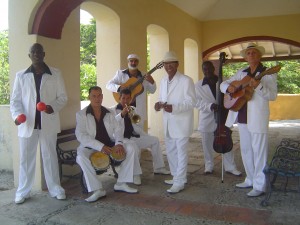 For more than 80 years and in over 35 countries, the Septeto Nacional Ignacio Piñeiro de Cuba has been the greatest and first champion of the traditional sound of the Cuban son. From the unmistakable twang of the tres to the smoky vocals of Eugenio “Raspa” Rodriguez, it is impossible to resist the infectious rhythms of this celebrated ensemble. The SNC performs some of the most treasured and well-known Cuban songs in the tradition of Ignacio Piñeiro Martínez, the legendary founder of the Septeto’s first incarnation in 1927 and one of the most important composers of son music. The group’s exceptional musicianship is firmly rooted in the musical explosion of Cuban son that took place during the 1920s and 1930s, evoking the nostalgic elegance of the dancing ballrooms and clubs of the era. The SNC recently played in the US for the first time since 1933 – more than 75 years ago. They are masters of Afro-Cuban rhythm and spirit, adding a splash of rumba to its son and delivering infectious, up-tempo fun. This band may be official cultural ambassadors from Cuba, but they know how to throw a party!
For more than 80 years and in over 35 countries, the Septeto Nacional Ignacio Piñeiro de Cuba has been the greatest and first champion of the traditional sound of the Cuban son. From the unmistakable twang of the tres to the smoky vocals of Eugenio “Raspa” Rodriguez, it is impossible to resist the infectious rhythms of this celebrated ensemble. The SNC performs some of the most treasured and well-known Cuban songs in the tradition of Ignacio Piñeiro Martínez, the legendary founder of the Septeto’s first incarnation in 1927 and one of the most important composers of son music. The group’s exceptional musicianship is firmly rooted in the musical explosion of Cuban son that took place during the 1920s and 1930s, evoking the nostalgic elegance of the dancing ballrooms and clubs of the era. The SNC recently played in the US for the first time since 1933 – more than 75 years ago. They are masters of Afro-Cuban rhythm and spirit, adding a splash of rumba to its son and delivering infectious, up-tempo fun. This band may be official cultural ambassadors from Cuba, but they know how to throw a party!
Jazz Series packages (all four concerts) range from $60 to $160. Subscription renewal packets and brochures will be mailed in early May.
Tickets to individual events on the series go on sale on Monday, August 23 (via www.ums.org) and Wednesday, August 25 (in person and by phone).


